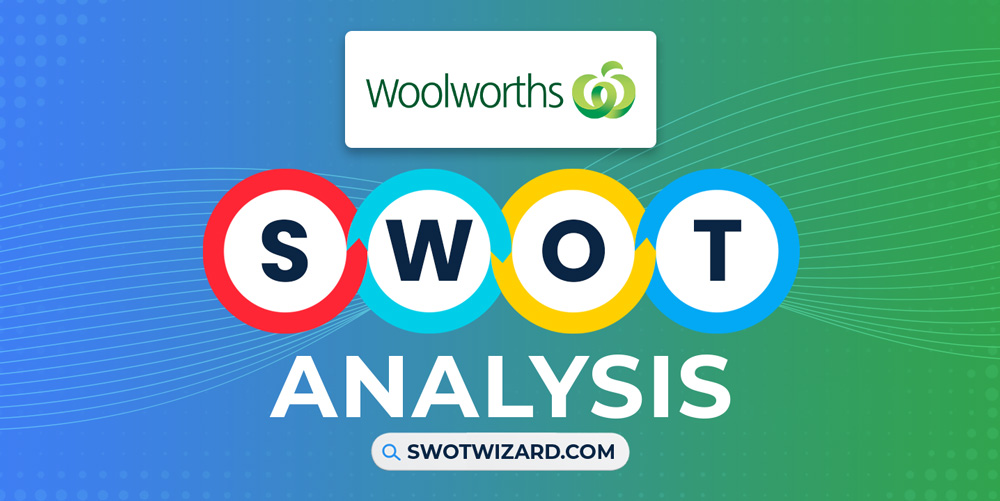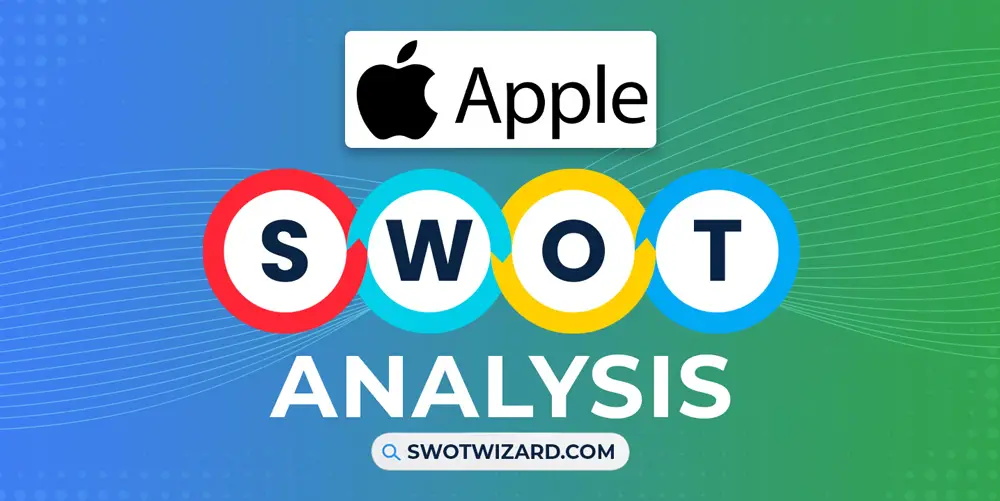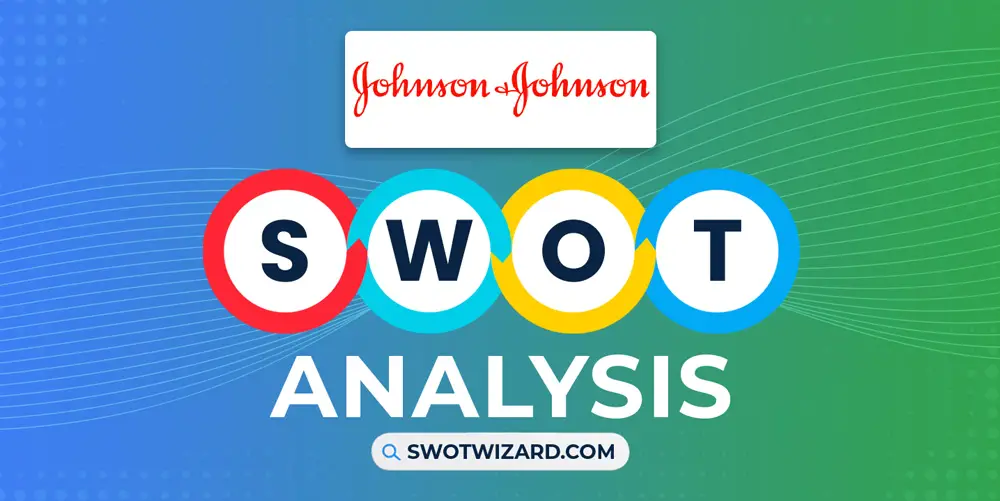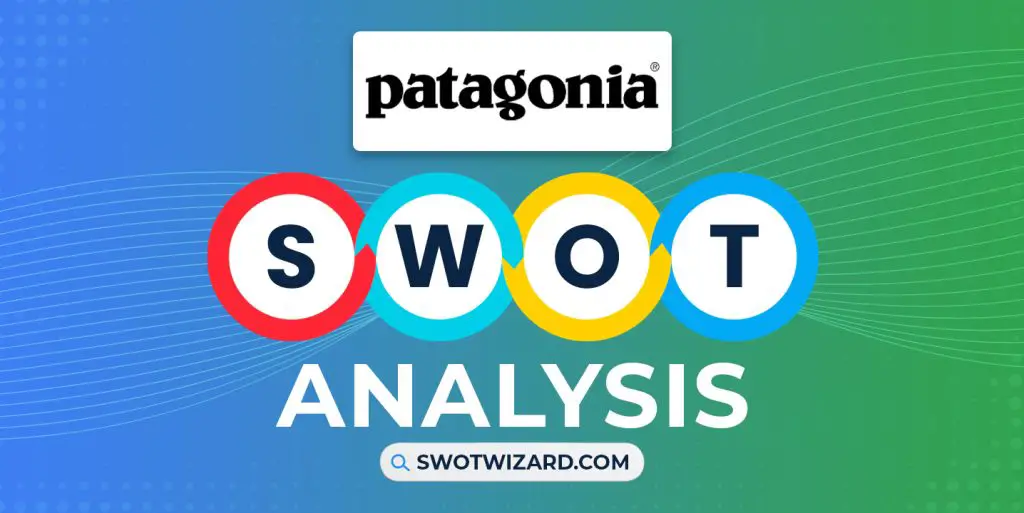It is almost impossible to notice a Woolworth store if you have ever been to Australia. Even though we know it as a retail company, the product line list is long. With many strengths like market leadership and many opportunities to grab, Woolworth is facing many weaknesses and some threats in the coming days that need to be overcome, which we will get to know in this Woolworths SWOT analysis.
Woolworths: Company Overview
| Company | Woolworths Group |
| Industry | Retailing |
| Founded | 22 September, 1924 |
| Founder | Percy Christmas, Stanley Chatterton, Cecil Scott Waine, George Creed, Ernest Williams |
| CEO | Bradford Banducci |
| Headquarter | Bella Vista, New South Wales, Australia |
| No. of Employees | 215,000+ |
| Annual Revenue | A$63.67 billion (FY 2020) |
| Website | woolworthsgroup.com.au |
Although the Woolworths supermarkets were founded almost a hundred years ago, in 1924, by Percy Christmas, the mother company, F. W. Woolworth Company, was founded in 1879. At first, it was just a retail chain idea, and then it expanded its operations to include supermarkets, which became the company’s primary focus.
It has around 2000 stores across Australia and New Zealand, including supermarkets, liquor stores, and convenience stores. Woolworths is headquartered in Sydney, Australia, serving millions of people with over 197.77K employees.
In the financial year 2022, Woolworths reported revenue of $41.86 B, and with sustainability goals, it is going more vital than ever.
Product & Services of Woolworths
Groceries | Magazines | DVDs | Health and Beauty Products | Household Products | Pet and Baby Supplies | Stationery
Woolworths Competitors
Coles | Walmart | Target | Tesco | Kroger | Amazon | Aldi | Lowe’s | Walgreens
Did You Know?
Back in 2008, Woolworths was the first retailer to introduce self-serve checkouts when no one even dreamed about allowing customers to scan and pay for their groceries.
Strengths – Woolworths SWOT Analysis
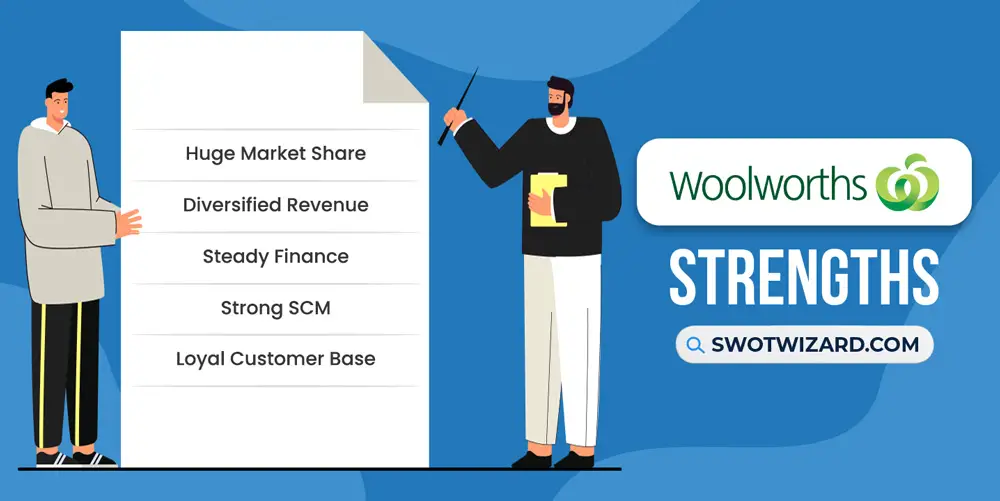
Huge Market Share: With a 37% market share, the company holds the market leadership position in Australia. Besides, it is also a leader in the online grocery market in Australia, with a market share of around 34%. More than 1,453 stores are in Australia, as per the latest data, which makes the company reach mass consumers with various products.
Diversified Revenue: Behind the company’s growth, long product lines keep the revenue afloat and help grow the business. Those lines include supermarkets, liquor retail, 300 hotels, financial services, etc. As a result, even during the economic downturns, it helped the company maintain its market leadership position and withstand challenges.
Steady Finance: A company’s every single aspect is equally crucial, and thanks to the diversified product lines, the revenue, and overall financials are on an upward trend for the company. In 2022, the revenue was at 1.51 billion Australian dollars, and all the other financial rations increased after the pandemic.
Strong SCM: No company can survive this long without effective and efficient supply chain management. Woolworths has the perfect system of a diverse network of suppliers to source high-quality products, advanced inventory management systems, a sophisticated distribution network, and advanced technologies to leverage the overall design.
Loyal Customer Base: To maintain a positive reputation in the market and grow the consumer base, the company has several approaches, such as excellent customer service and online experience, rewards programs, the vast availability of stores, etc. Besides, when customers get everything they want and are rewarded, the loyal customer base continually grows.
Weaknesses – Woolworths SWOT Analysis
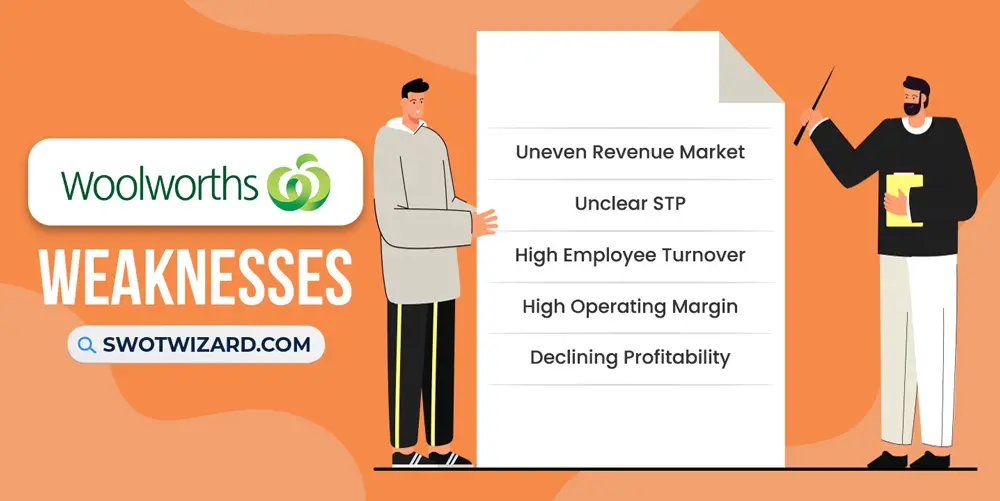
Uneven Revenue Market: The company has a presence in thirteen countries with around 1.5K stores, but the majority, almost 80% of the stores in Australia alone. As a result, most revenue comes from this single market alone, making it heavily relied upon or dependent on the market.
Unclear STP: With these vast product lines, most companies have specific target markets and positioning strategies with particular product lines. But, in the case of Woolworths, their plan for different markets, targeting consumers, and positioning strategies are vague and send mixed signals.
High Employee Turnover: As we all know, the overall expense of hiring a new employee is always more than existing and experienced ones. Woolworths’s employee turnover rate is very high; employees just resigned, and the company fired people without giving them the full salary amount in 2020. As a result, it damaged morale and lost the trust of the current employees.
High Operating Margin: Even though the company’s high operating cost was justified due to keeping a solid market position, given the circumstances, all the inflation, recession, and economic downturns, it is going to hurt the company’s finance badly. It could result in losing the market leadership position and a higher economy of scale.
Declining Profitability: One of the significant weaknesses the company has been facing for a few years is declining profitability. During the 2020 pandemic, the company’s revenue and profitability went downward. Since then, even though the revenue has returned, the profitability didn’t and currently stands below the industry standard.
Opportunities – Woolworths SWOT Analysis

Market Expansion: As the company is entirely focused on a few markets, mainly in Australia, it is high time Woolworths started expanding into new markets, such as New Zealand or Asia. It will balance the revenue stream and portfolio and stabilize and increase profitability.
Organic Product Line: In 2022, the organic (Foods) market was at $208.19 B, and with a 13% growth rate, it is estimated that the market size will be $564.22 B within a decade. People now prefer organic foods, so it is the perfect market to expand to reach a new market segment.
Tech Adaptation: With more advanced tech, Woolworths can leverage technology and innovation to improve its operations and customer experiences, such as implementing automated checkout systems, and improving its supply chain management, resulting in more foot traffic in the stores increasing revenue.
Strategic Collaboration: There are already many collaborations with the company, but there are some opportunities to grab to enhance its capabilities and strengthen its market position, such as a partnership with Disney, celebrity endorsement, Amazon partnership which can enable Woolworths to expand its product range and tap into Amazon’s customer base.
Threats – Woolworths SWOT Analysis

Tough Competition: Woolworths operates in a highly competitive market, with competition from other supermarket chains, such as Coles, Aldi, Kroger, Target, etc. Not just it’s challenging to keep up with the economy of scale and tackle the strategic moves from the competitors’ dynamic pricing strategies.
Political Instability: Any kind of political instability in the region can significantly impact Woolworths’ operations, mainly if it occurs in the countries where it operates or sources its products from, such as India, the United States, China, etc. Any trade block, policy, or regulatory change can significantly harm the company.
Flat Growth Rate: Being the market leader and competing in a saturated market, the company has little to no room for growth. Even though sales are increasing, the overall market is unbalanced because of market saturation, constant consumer preferences change, and limited innovation.
Economic Factors: After the pandemic, we face two new challenges in 2023: inflation and recession. These economic downturns can lead to reduced consumer spending, lower revenue, and reduced profitability. Rising inflation and interest rates can also increase Woolworths’ operating costs and reduce its margins.
Supply Chain Issues: The company’s supply chain is subject to various risks, which can impact its ability to source and distribute products, potentially leading to reduced sales and profitability. In March 2023, many giant retailer companies, including Woolworths, faced supply chain disruption regarding the freight company collapse.
Security Breach: As a large retailer, Woolworths faces cybersecurity risks, such as data breaches, which can have significant financial and reputational impacts. In 2022, the cyber attacks breached the security and stole 2.2M consumer data, significantly harming consumer trust in the security issues.
[Bonus Infographic] SWOT Analysis of Woolworths
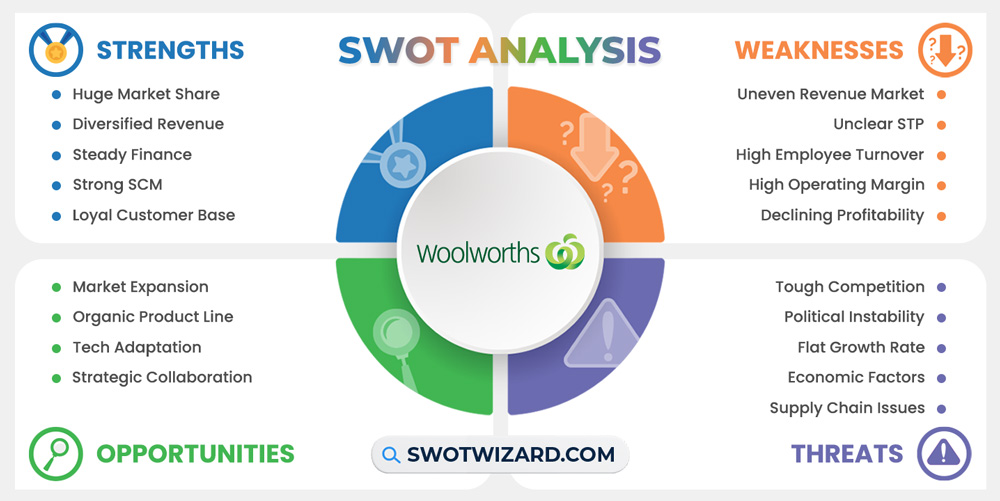
Recommendations for Woolworths
As we went through all the aspects, now it is time to think about the future for Woolworths and how they could survive in the market, tackle the challenges, and grab opportunities.
- The company should focus on new product lines to remain competitive and attract customers, meaning expanding the product portfolio, such as organic products.
- Woolworths could expand its operations into new markets or geographies to increase its revenue and market share.
- Woolworths should prioritize improving employee retention rates to reduce turnover costs and maintain a skilled workforce.
- Strategic collaboration could help the company enhance its capabilities, expand its product range, and tap into new customer segments.
Frequently Asked Questions (FAQs)
What Is Australia’s Biggest Supermarket?
Australia's biggest supermarket is Woolworths, with over 36% market share in 2022.
How Many Countries is Woolworths In?
Woolworths is in thirteen countries, with 1,451 in 2022.
Final Words on Woolworths SWOT Analysis
Woolworths is a leading Australian retailer with a strong brand image and a diversified revenue stream. The company has a loyal customer base and a high operating margin, but faces challenges such as high employee turnover and intense competition. Woolworths has opportunities for growth in expanding its operations, improving supply chain management, and innovating new products and services. Woolworths must focus on employee retention and adapt to changing consumer preferences to remain competitive.
References
- Wikipedia contributors. (n.d.). Woolworths Group (Australia) Wikipedia.
- Woolworths to power next generation supply chain through Primary Connect platform. (2020, October 29). Woolworths Group.
- Weber, K. (2023, February 13). Woolworths to broaden online marketplace. iTnews.
- Butler, B. (2020, June 23). Woolworths to cut 1,350 jobs and admits it owes at least $90m more to underpaid workers. The Guardian.
- WOOLWORTHS GROUP LIMITED Key Stats and Ratios. (n.d.). TradingView.
- Organic Food And Beverages Market Report, 2022-2030. (n.d.). Grand View Research.
- Woolworths rolls out innovative micro-fulfilment tech in Melbourne to deliver more online grocery orders to customers faster. (n.d.). Woolworths Group.
- Achenza, M. (2022, June 26). Woolworths partners with Disney to launch new kids collectibles. News.com.au.
- Davidson, H. (2014, May 26). Coles and Woolworths urge deregulation of retail trading hours. The Guardian.
- Woolworths sales growth wilts as more people eat out, while David Jones remains a drag. (2022, July 26). News24.
- Jha, S. (2023, February 9). Inflation and recession: Can the world defeat both in 2023? Al Jazeera.
- Aldi, Coles, Woolworths shoppers face empty shelves after freight company collapse. (2023, March 8). Yahoo News.
- Kovacs, E. (2022, October 17). Retail Giant Woolworths Discloses Data Breach Impacting 2.2 Million MyDeal Customers. SecurityWeek.

